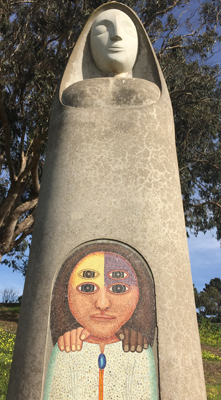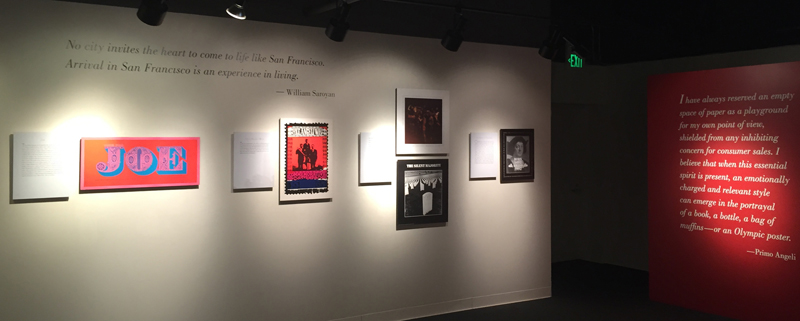Curated by Mary Serventi Steiner. Museo Italo Americano, San Francisco, California.
December 5, 2014 - May 31, 2015.
Exhibition review by Lincoln Cushing in Italian American Review 5.2, Summer 2015
Primo Angeli is the son of working-class Italian immigrant parents who had settled in southern Illinois. Wending westward after design school, he made it to the San Francisco Bay Area in 1959 and never looked back. He soon built a successful practice specializing in corporate branding, advertising, and packaging. Angeli sold his firm in 1999 and lived in his ancestral homeland of Umbria for ten years, returning to San Francisco to partner with the local firm of Primo Angeli-Stapley Hildebrand. This exhibition reviews his life's work. The exhibit was designed and curated by Museo Italo Americano staff under the careful watch of Angeli, who offered thoughtful feedback and guidance. Angeli's alma mater Southern Illinois University exhibited a retrospective in 2012; the Museo's version reused several of the posters but was able to offer more content and a different exhibition design.
The Museo Italo Americano is housed at Fort Mason Center, a former military complex at the edge of San
 Francisco Bay. On the hill above the site stands a gorgeous statue by
another San Francisco Italian-American artist, Beniamino "Benny" Bufano
(1890 - 1970). I felt that his granite-with-mosaic-inlay work "Madonna
Protects the Children of the World" served well to introduce the
Italian cultural treasures below.
Francisco Bay. On the hill above the site stands a gorgeous statue by
another San Francisco Italian-American artist, Beniamino "Benny" Bufano
(1890 - 1970). I felt that his granite-with-mosaic-inlay work "Madonna
Protects the Children of the World" served well to introduce the
Italian cultural treasures below.The exhibition occupies several rooms and features approximately fifty-six items on the walls with additional pieces staged in vitrines. A screen displays a slideshow with photos, provided by Angeli, of his personal and professional life, but without captions many of the images are stripped of meaning - it would be useful to know where or when a photo was shot and who the subjects might be. The video's dulcet "Ave Maria" soundtrack drifts through the display spaces, adding an Italian layer to the exhibition.
Angeli's list of corporate clients was extensive and impressive and included giants such as DHL, Coca-Cola, the U.S. Olympic Committee, Guinness, and Xerox, among others. The Robert Mondavi Winery, Levi Strauss, Molinari & Sons, and Boudin Bakery numbered among his local clients. The large, well-lit displays confirm Angeli's mastery of crisp, clean design and creative typography. His skill and background in printmaking are evident in the way he neatly treats colors, shapes, and spaces in his work. But there is more to Angeli than just another sleek corporate brander, and that is revealed in some of the selected pieces and their stories. Here is where Angeli's caption titles elevate the discourse.
Near the front of the exhibition is a poster Angeli designed for the successful 1967 mayoral campaign of Italian-American native son and Democratic politician Joseph Alioto. The small, horizontal poster simply consists of the giant word "JOE" (the tiny words "Vote for" are almost invisible) rendered in the distinctive floral and psychedelic coloration and style that mid-1960s San Francisco brought to the world; a tiny photograph of the candidate graces a design frill in one of the letters. The fine type at the bottom reads: "Joseph L. Alioto For Mayor: For Fair Taxes, Better Housing, Safety In The Streets For All Races, Transportation Coordination, Training And Jobs For All, For You. Joe Alioto For Mayor." Just as Shepard Fairey's 2008 "Hope" poster made a difference in Barack Obama's election, in this reviewer's opinion this unusual campaign poster surely was helpful to Alioto's successful campaign.

Two other 1969 pieces are paired by Angeli and get called out with a signed exhibition caption. "Aquarius" announces the opening of the San Francisco musical production of Hair, and the second poster offers a somber commentary on the term "the silent majority," coined in a speech by President Richard M. Nixon. Of the video display in the exhibition Angeli notes, "After all these years, I am still emotionally taken at seeing these two poignant visual statements together . . . as one dissolves over the other, it becomes a before-and-after portrayal of young adults with so much life and carefree joy caught during a terrible time." "The Silent Majority" is perhaps Angeli's most political piece, and he comments in the wall text that the image "portrayed the reality of war and was a touchstone for all sides for or against the war."
There is more to the story of this poster, made during a fervent period when the quality and the quantity of powerful antiwar art were beginning to peak. Angeli's poster is based on a photograph of military tombstones taken by artistic collaborator Lars Speyer, who died in 2007 (and to whom Angeli dedicated this exhibition). Although credited as having been shot at the "Colma military cemetery," this is an error. That small city has many private cemeteries but no military ones. The photo was most likely taken at Golden Gate National Cemetery in nearby San Bruno, south of San Francisco.
In 1969 two huge antiwar marches in San Francisco took place on April 6 and November 20. The speech in which Richard Nixon most publicly used the term "silent majority" was given November 3, 1969, and firsthand accounts of the November 20 demonstration recall copies of Angeli's poster being distributed and displayed. A subsequent poster, based on the same photo but bearing the bold headline "No Christmas as Usual" and with a wreath on the foremost tombstone, was produced by the national organization New Mobilization Committee to End the War in Vietnam. That meant that Angeli's original poster ended up in the hands of someone responsible for the Mobilization poster by mid-December. That was tight timing, by pre-Internet standards, but such things happened. Posters went viral before "viral" existed.
Among Angeli's cultural community was the well-known local Beat poet and playwright Michael McClure. A framed poem is accompanied by the charming caption explaining that McClure had written it as payment for a newspaper ad Angeli had produced for McClure's controversial play "The Beard." The quoted material in the caption is taken from the poem itself: "It was written on a plain sheet of paper, with all the essential stuff, not a wasted stroke. I thanked him, went to my studio, and framed it. That was in 1965. Now, looking back at the poem, written in lead pencil on off-white paper, I can fully appreciate the way in which he has brought in a whole gas tank of 'alchemical motions' that is truly 'outlined by neon' in the color of his poetry."
Other posters reveal Angeli's political and artistic iconoclasm. "The Death of Columbus" is a sarcastic riposte to a design project that ran into enormous sensitivity challenges. Angeli agreed to design, pro bono, an official commemorative poster for the 500th anniversary of Columbus's arrival in the Americas. After criticism from various communities about such a controversial celebration, the poster project was severely scaled back. A frustrated Angeli produced his own poster, with a teary Columbus and the headline "Born 1492 - Killed 1992." The poster's surrounding text begins: "Here lies an Italian sailor, stripped as some would have him, with image drawn and quartered by divided persons."
During the 1992 quincentennial, social justice groups, and indigenous-rights organizations all over the United States took the opportunity to critique the conventional "Columbus narrative" and reframe it as one of occupation, genocide, and imperialism. One poster's slogan was "Columbus: Liar, Slaver, Murderer, Thief," another boasted of "The Vengeance of Montezuma," and a third "Wanted: Christopher Columbus [for] Grand Theft, Genocide, Racism, Initiating the Destruction of a Culture, Rape, Torture, and Maiming of the Indigenous People and Instigator of the Big Lie." The quincentennial's reactive message became "500 years of resistance." Of the scores of posters made about Columbus's negative role in the conquest of the Americas, Angeli's is one of the very few honoring it.
Primo Angeli is truly an icon of graphic design in a community known for outstanding graphics. There is no published catalog, although reproductions of most of the display items as well as Angeli's books are available at the museum store.
Return to Docs Populi - Documents for the Public
updated 4/23/2021